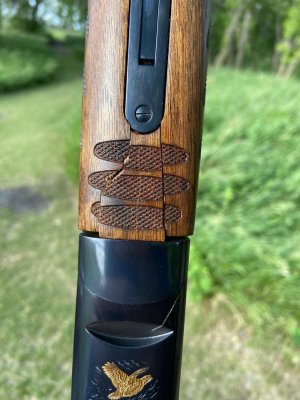I dont have that much experience with shotguns, but I think I see the problem. Have you ever noticed there is some movement when you set rings in a rail mount? So many people have the recoil action reversed in their mind and snug up the rings while forcing them backwards. The rifle recoil back, but that pushes the scope forward so the rings shoukd be snugged up while forced forward. The affect of recoil shows on that forearm. If you notice the small wedge in the center is still back tight against the base because it's forward movement was arrested by the screw you see at its front. I think this indicates loose lockup of the forearm is allowing forward movement of the forearm. I bought my first double two weeks ago and have given such little attention to shotguns that I don't have the terminology down yet. Anyway a gunsmith may have to weld a tiny drop at the rear edge of the lockup and file to correct fit to take up the slop that is allowing that forward slip.
Edit: Perhaps it is as simple as removing the two screws that hold the locking mechanism that is part of the forearm and epoxy bedding it an eighth inch forward which would force it more tightly back. It may creat a small unsightly gap at the rear of the inlay that should be the same as the gap you now see between the forearm and the base. Use the right color bedding and it will be near invisible.
Edit ------ again. Sorry, thinking as I type. Do you notice the gap all around the wood to metal fit? Notice the gap between the wood and metal at the back? The screw was the only thing stopping the forward movent of the forearm under recoil. Since this forearm is already brokenI would use Acraglass, or I think Brownells still has a brown epoxy which is easier to use, and glue the forest back together. Then glass bed the metal plate into the forearm so there is no gap anywhere. I use paste furniture wax as a release agent when glass bedding an action, and would suggest doing that when bedding the locking mechanism into the forearm. That forward slip may not be the fault of the locking mechanism. but simply the poor wood to metal finish. It looks like all the forward movement comes to bare on that screw rather than the entire metal inlay. As a matter of fact disregard my first paragraph. I think the whole problem is poor wood to metal contact. To large an inlay for the baseplate of the locking mechanism.


